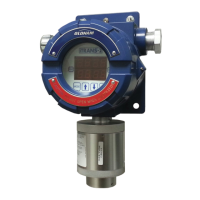
Do you have a question about the Oldham iTrans 2 and is the answer not in the manual?
| Enclosure | Aluminum or Stainless Steel |
|---|---|
| Target Gas | Combustibles, H2S, CO, O2 |
| Output | 4-20 mA, HART |
| Display | LCD |
| Hazardous Area Approval | ATEX, IECEx |
| Operating Humidity | 0-99% RH (non-condensing) |
| Resolution | Varies by gas |
| Response Time | < 30 seconds |
| Protection Rating | IP66 |
| Measurement Range | Varies by gas. Combustibles: 0-100% LEL, H2S: 0-100 ppm, CO: 0-500 ppm, O2: 0-25% vol, NH3: 0-100 ppm, Cl2: 0-10 ppm, HCN: 0-30 ppm, NO2: 0-10 ppm, SO2: 0-20 ppm |
Describes the iTRANS-2 fixed gas monitor, its capabilities, and features.
Details how to connect control wires to the relay terminals for alarm and fault signals.
Explains how to connect power supply and 4-20 mA output signals to connector J1.
Describes connecting sensor wires to connector J3, including wire color coding.
Covers connecting the ModBus interface to digital control systems, PLCs, or HMIs.
Introduces the two programming modes (non-intrusive and push-button) and their functions.
Explains how to use a magnetic wand for configuration tasks like sensor type, zeroing, and calibration.
Explains the process of zeroing the instrument using keypad or magnetic wand.
Details the process of calibrating the instrument using keypad or magnetic wand.
Explains how to set the span gas concentration for calibration.
Describes how to access programming options using physical keys after entering a password.
Details how to set the low alarm threshold for a channel.
Details how to set the high alarm threshold for a channel.
Explains how to read gas readings from Channel 1 and Channel 2 via the ModBus network.
Provides a detailed list of ModBus registers, their addresses, and descriptions.
Provides instructions for qualified personnel to replace a sensor.
Details the methods for zeroing and calibrating the instrument.
Presents common symptoms, their potential problems, and solutions in a table format.